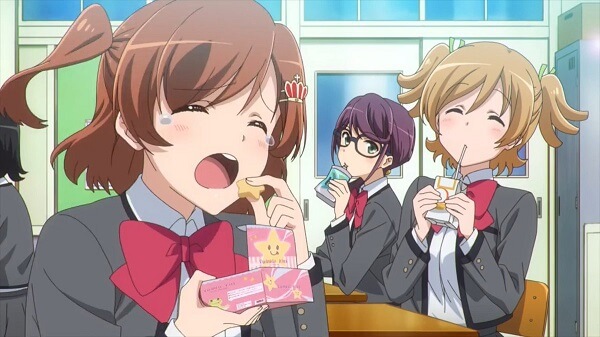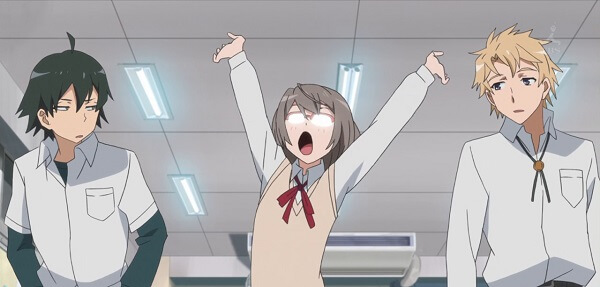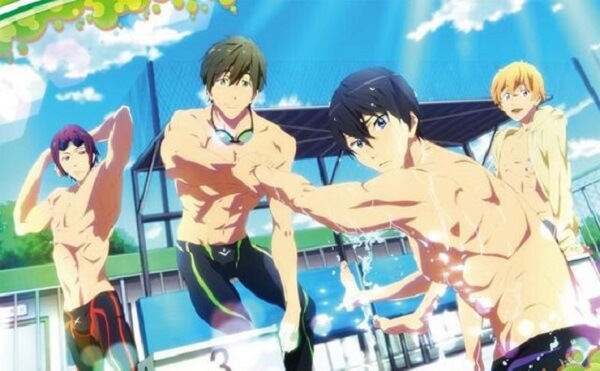Years ago, you could say that if an anime had an overwhelmingly male cast, the intended audience was obvious; this was clearly a show for male fans. However, in recent years, that old expectation has been gradually rewritten. Enter the fujoshi, who has an endless supply of “shipping” enthusiasm and a corresponding amount of discretionary income.
Fujoshi is a mocking term that basically means to “rotten girl” and refers to female anime fans who are obsessed with picturing attractive male characters in relationships with one another. (The male counterpart, Fudanshi, is less well-known.) Its definition is a derogatory indictment of the fujoshi’s filthy mind; she understands that the narrative of her favorite shows isn’t explicitly gay, but that doesn’t stop her from imagining it that way, however “rotten” it may appear to some.
So, what is it about homoerotic relationships between male characters that fascinates Fujoshi? You’d think fujoshi would appreciate a fictional relationship between a male and female character in order to self-insert as the woman, but you’d be wrong.
The entire point, according to fujoshi, is to observe a relationship between two attractive men from afar. “When it’s just boys, the reader engages in the story from the third person,” Hana, a Tokyo fujoshi, said of her hobby to the Daily Beast.

Fujoshi fantasies had found a home in fan art and fanfiction for years before much change in the market, but anime producers eventually became more than happy to cater to fujoshi. This gradual shift can be attributed to two factors: the Odagiri effect and female fans’ increased purchasing power.
What exactly is the Odagiri effect? In the year 2000, Japan witnessed the rise of a popular children’s show called Kamen Rider Kuuga, starring actor Joe Odagiri as the titular Masked Rider Yusuke Godai.
Despite the fact that the show was intended for children, Odagiri was so attractive that moms began to tune in as well, and the show gained an unexpected secondary main audience of housewives! A show with two audiences is better than one, and it became economically prudent to air shows starring increasingly attractive men, both live action and animated.

There’s also the relatively recent discovery that female otaku are making a killing. “Female otaku have the most spending power among the otaku population, which is one of the reasons why you see an increase in boy’s love publications and anime featuring good looking guys,” noted prominent Japanese pop culture blogger Danny Choo to CNN.
Women with money, according to Japanese blogger MoePre, have turned the Shounen Jump selection model on its head in the last decade, as catering to women has gone from occasional to essential for the magazine’s titles. Prince of Tennis may have been aimed at young children, inspiring a new generation of tennis fans, but it was adult women who spent big bucks selling out musical stage plays and collecting merchandise.
Fujoshi are currently gravitating toward two major genres:
Idol Anime
There was a time when idol shows would feature a female idol surrounded by a plethora of handsome male idols so she could eventually choose one as her lucky beau. But, unlike boys’ sports shows, which have always been dominated by men, idol shows for girls have simply piled on more bishounen. From STARMYU to Uta no Prince Sama, the emphasis has shifted away from one of the few female characters finding love and toward how the boys interact with one another.
The double-fanservice of 2016’s B-PROJECT is particularly telling: it features a female manager who excels at her job by assisting her male idol groups in resolving conflict and developing deeper friendships with one another. It’s especially telling that B-PROJECT was created by the same team that created UtaPri, because that franchise has evolved in line with these overall trends over the course of four seasons. While the first couple seasons emphasized the leading lady’s one-on-one relationship with her potential idol boyfriends, recent seasons have shifted to an ensemble focus on the boys’ relationships with one another.

There’s also the idea of performance, which is so central to idol shows. When male idols dress up in elaborate costumes and perform on stage, they are transforming themselves into their most attractive forms for the benefit of an unseen female audience. The heated conflicts and rivalries between showbiz stars can appeal to the same fantasies as sports rivalries. As a result, idol shows for fujoshi have begun to resemble the polar opposites of idol shows for male anime fans.
Idol shows aimed at men are increasingly featuring all-female casts (Love Live!, in particular, appears to exist in a world without men entirely), highlighting the female characters’ relationships and moe appeal. The goal for both audiences is to ensure that everyone who appears on screen can be a potential object of desire, whether it’s a romantic yearning for that character, a romantic yearning for that character to romantically desire their friends, or any number of feelings in between!
To summarize, apart from cute boys and a lack of female characters, what do all of these examples have in common? Relationships between male characters that defy expectations. In the high-intensity fields of sports and show business, where every pass, every stare-down, every competition is a life-or-death situation, the intense friendships and rivalries that sports characters develop can often feel like something more.
Is any of this emotional stuff done on purpose to get Fujoshi’s wheels turning? Not nearly as much as you might think. In a world where the two default types of relationships available to men are sexual and violent, any show with a diverse cast of male characters engaging in a variety of male relationships and types of intimacy can double as fujoshi fanservice.
So now that publishers know their highest paying audience will appreciate the effort, it doesn’t take much extra work to make those characters a little more handsome or add a little extra closeness between them. While these two genres are currently the most popular, anime does not have to fall into any specific genre to attract fujoshi fans—having at least two male characters who interact in just the right way can suffice.
Sports Anime
Who watches anime about sports? Given the genre’s focus on high school male athletes and the stories’ primary origins as Shounen Jump manga, it makes sense to say “boys.”
However, anyone who follows the sports anime fandom knows that this is no longer the case. In recent years, sports anime has attracted a sizable secondary audience of women (and, to a lesser extent, gay men) who are drawn to the athletic casts of each show.

As a result, male characters in sports manga and anime have become hotter, but there are still few female characters (due partially to the lack of mixed-gender sports teams in reality or fiction). This has made sports anime the ideal setting for fans to fantasize about romantic relationships between these male characters in their isolated fantasy worlds of muscle and sweat.
Aside from Yuri!!! on Ice, gay representation in sports anime is extremely rare, but sports shows in particular make it easy for fans to channel their inner fujoshi or fudanshi. The narrative of athletic stories, in which characters are portrayed as devoted best friends or fiery rivals, has a lot of emotional power. Add in the blood, sweat, and tears of high-stakes hard work, and you’ve got a recipe for dramatic romance.
Also Read: Antje Utgaard, Yasmin Vossoughian , Ahna O’Reilly, Nurdian Cuaca
